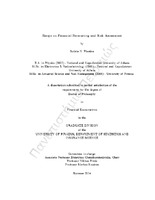| dc.contributor.advisor | Χατζηκωνσταντινίδης, Ευστάθιος | |
| dc.contributor.author | Πλαστήρα, Σωτηρία Ν. | |
| dc.date.accessioned | 2015-07-15T09:32:48Z | |
| dc.date.available | 2015-07-15T09:32:48Z | |
| dc.date.issued | 2014 | |
| dc.identifier.uri | https://dione.lib.unipi.gr/xmlui/handle/unipi/6846 | |
| dc.format.extent | 161 | el |
| dc.language.iso | en | el |
| dc.publisher | Πανεπιστήμιο Πειραιώς | el |
| dc.rights | Attribution-NonCommercial-NoDerivatives 4.0 Διεθνές | * |
| dc.rights.uri | http://creativecommons.org/licenses/by-nc-nd/4.0/ | * |
| dc.subject | Διαχείριση κινδύνου | el |
| dc.subject | Μετοχές -- Τιμές -- Οικονομετρικά μοντέλα | el |
| dc.subject | Επενδύσεις -- Αξιολόγηση | el |
| dc.subject | Stocks -- Prices -- Econometric models | el |
| dc.subject | Stock exchanges | el |
| dc.subject | Financial risk management | el |
| dc.subject | Stock price forecasting | el |
| dc.subject | Investment analysis | el |
| dc.title | Essays on financial forecasting and risk assessment | el |
| dc.type | Doctoral Thesis | el |
| dc.contributor.department | Σχολή Χρηματοοικονομικής και Στατιστικής. Τμήμα Στατιστικής και Ασφαλιστικής Επιστήμης | el |
| dc.identifier.call | 332.63 ΠΛΑ | el |
| dc.description.abstractEN | This thesis aims at investigating the performance of empirical risk factors in financial forecasting and their assessment with respect to the associated risk. The thesis consists of four essays. The first essay focuses on whether the empirical HML and SMB risk factors, along with the long-term reversal and the momentum factors exhibit both in-sample and out-of-sample forecasting ability for the U.S. stock returns, compared to the performance of the most widely used financial variables. Our findings point to the superior forecasting ability of the empirical factors. We also establish a link between financial variables and the empirical factors and find that the default and the term spread proxy for the evolution of the factors examined. The second essay extends the previous analysis by investigating the out-of-sample forecasting ability of the full set of empirical factors along with their size and value decompositions on U.S. bond and stock returns for a variety of horizons ranging from the short run (1 month) to the long run (2 years). We also examine their performance by employing combination of the individual forecasts of the empirical factors. It turns out that these combining methods lead to particularly successful results, especially from an asset allocation perspective, with similar findings pertaining to the European and Japanese markets, as well. The third essay employs a variety of risk indices in order to quantify the embedded risk of different empirical factor portfolios, producing a relative ranking among them. The analysis also contributes to the literature by establishing a connection between size, book- to-market and stock prior-returns with risk, revealing that small size, high book-to-market and low momentum/reversal effect are related with high portfolio risk. Finally, the fourth essay provides an extensive review on traditional and more sophisticated evaluation measures focusing on premium returns adjusted for the associated risk. The implementation of these performance measures on the aforementioned empirical factors reveals that the value and momentum factor portfolios achieve the best and worst performance, respectively. | el |



